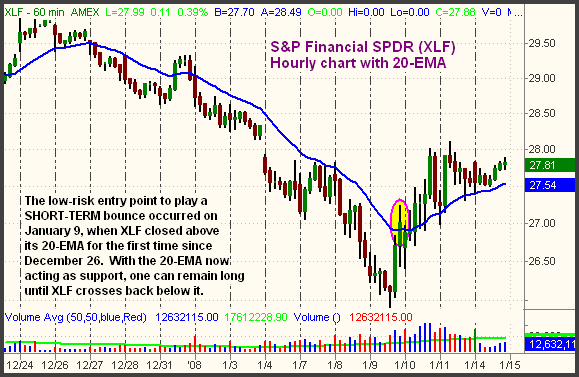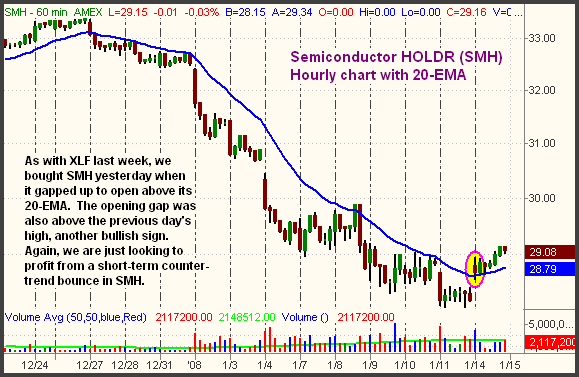Deron Wagner won't expect to see much bullish momentum in the main stock market indexes unless stocks begin to break out above resistance of their January 10 highs.
Stocks managed an encouraging start to the week, as the major indices recovered a majority of last Friday's losses. Led by a rare, stealth rally in the Semiconductor Index ($SOX), the Nasdaq Composite gained 1.6%. The S&P 500 and Dow Jones Industrial Average advanced 1.1% and 1.4% respectively. The small-cap Russell 2000 climbed 1.1% and the S&P Midcap 400 rose 1.0%. Equities lacked momentum into the close, but the main stock market indexes still finished near their intraday highs.
Lower turnover was the main disappointment of yesterday's session. Total volume in the NYSE declined 16%, while volume in the Nasdaq was 5% lighter than the previous day's level. In both exchanges, trading fell below 50-day average levels for the first time in more than a week. This tells us institutions were not really interested in accumulating new positions. Rather, the lower volume gains tell us the market's advance was more the result of a lack of aggressive selling than heavy buying of new positions. This is negative because low volume rallies can easily come undone by just one bout of distribution by the bears.
Over the past week, we have taken two very short-term trades in weak ETFs that began to bounce off their lows. We held the first trade, a long entry in the S&P Financial SPDR (XLF), for two days before selling for a quick gain. Then, we bought the Semiconductor HOLDR (SMH) for a similar short-term trade yesterday. The position is still open, but showing an unrealized gain as of yesterday's close. Buying stocks and ETFs at their dead lows is a dangerous game because it's impossible to know how low they will go before finding support. However, one simple indicator that does a great job at accurately providing low-risk entry points on near-term trend reversals is the 20-period exponential moving average (EMA) on the hourly chart interval. This was the main indicator for providing our entry points in both XLF and SMH. To illustrate how this works, first take a look at the hourly chart of XLF below. Although we also use the 40 and 200-period moving averages, only the 20-EMA is shown so that you can more easily see how well this indicator works in trending markets: 
From December 27, 2007 through January 8, 2008, notice how XLF closed below its 20-EMA every single day. On several occasions, XLF probed above its 20-EMA on an intraday basis, but failed to close above it. This is what happens when a stock or ETF is in a steady trend, either up or down. In this case, it's obviously a downtrend. On January 9, XLF finally closed above its 20-EMA. It was on that day, less than thirty minutes before the close, that we decided to buy XLF just for a near-term momentum bounce. Since then, observe how perfectly the 20-EMA has acted as support. This is because a prior area of resistance always becomes new support after the resistance level is broken (and vice versa). Choosing to take the quick, low-risk profit, we sold into strength near the intraday high of January 10. But even if one continued to hold XLF through yesterday, it is relatively safe to do so because XLF is still above its 20-EMA. On short-term trades, some traders also use the 20-EMA on the hourly chart to assist them in trailing protective stops. Next, let's analyze the hourly chart of SMH: 
Similar to XLF, notice how SMH has been trading below its 20-EMA on the hourly chart since December 26. Then, it gapped up to open above its 20-EMA yesterday morning. Because the move above the 20-EMA occurred on the open, we had no way of knowing if SMH would actually close above its 20-EMA yesterday. However, we know from experience that opening gaps above the 20-EMA are often bullish and indicative of a near-term bottom when the downtrend has been intact for several weeks. Further, the opening gap up was also above resistance of the previous day's high. Armed with the knowledge of these two bullish indicators, we bought SMH on yesterday's open. As you can see, it trended steadily higher throughout the day and finished at its intraday high. Going into today, we can now use new support of the 20-EMA as a guide to assist in trailing our stop higher, locking in profit and minimizing risk along the way.
If long SMH, be aware that chip giant Intel Corp. (INTC) reports quarterly earnings after today's close. If SMH shows enough of a profit buffer, we may hold it through the Intel report. Otherwise, we'll look to sell into strength sometime today. As always, we'll keep regular subscribers notified of any intraday action via real-time e-mail alerts. As we enter another earnings season, remember to keep an eye on the dates of earnings announcement of market-moving companies.
The overall stock market remains in a rather indecisive state, as the major indices have been see-sawing up and down in a wide range for the past five days. Yesterday, we discussed the key support levels of the January 9 intraday lows. So far, the main stock market indexes have firmly held above those levels. Nevertheless, we don't expect to see much bullish momentum unless stocks begin to break out above resistance of their January 10 highs. Such an occurrence could lead to a decent counter-trend bounce in the broad market, though it's unlikely most stocks would be strong to reverse their primary downtrends. Until we see a definitive move in either direction, below the January 9 lows or above the January 10 highs, we will avoid getting too aggressive on either side of the market.
Open ETF positions:
Long - SMH (near-term momentum play only)
Short - (none)
Deron Wagner is the Founder and Head Trader of both Morpheus Capital LP, a U.S. hedge fund, and Morpheus Trading Group, a trader education firm launched in 2001 that provides daily technical analysis of the leading ETFs and stocks. For a free trial to the full version of The Wagner Daily or to learn about Wagner's other services, visit MorpheusTrading.com or send an e-mail to deron@morpheustrading.com.